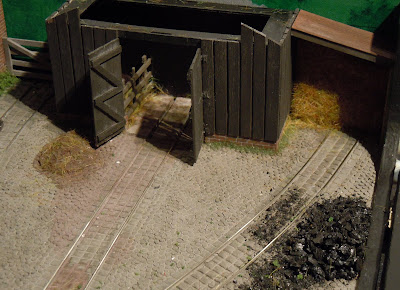And so to a job I have been thinking about for a while - laying the cobbles in the farmyard. As this covers the entire ground of the layout, including the track, it is pretty critical to the look and operation of the layout to get it right! Now I have read on the
NGRM Forum and also
Chris Nevard's Brewhouse Quay of using DAS clay for inset track. I last used DAS as a teenager for stone buildings but never got the stonework looking right, but that was some time ago so why not give it another go?
First as you will have seen previously the area between the tracks was covered in thick card up to sleeper height, then any gaps between the sleepers were levelled with small pieces of clay. I wanted to cover right up to the buildings, but didn't want to get them messed up, so gave them all a "skirt" of paper. This may not have been necessary as no doubt the clay could have been wiped off, but remember some of them need to be removable. Then the clay was rolled out to a thickness of about 1.5-2mm, cut to approximate shape (some paper templates were used), and laid onto a layer of PVA. The idea was to have the ground surface just below rail height, so as not to lift wheels off the track and to allow the rail head to be cleaned.

The picture above shows the clay being laid, that between the tracks in the centre has just been smoothed into place and is having the flange-ways opened out. 014 standards a fine-scale so the flange-ways are mercifully small, especially having been so used to 009! The dark clay beyond has just been laid and embossed with setts, while the lighter clay to the right has already dried. There you can see a mixture of setts (mostly around the rails and doorways) and cobbles, exactly as I saw at Tatton and something I wanted to reproduce. Cobbles help with the rural farmyard feel, setts throughout would have felt more industrial to my mind.

I embossed the clay whilst damp using a variety of home-made tools, shown above. On the left is a flat piece of plasticard with handle, sized to fit between the rails, used for smoothing and levelling the clay. Next is another one with slots for the rails, and ridges for the flange-ways. The black one is also for clearing flange-ways to the right depth. In the centre is a square-section plastic tube, and next to it a block of three, with chamfered ends used to emboss the setts. These work out about a scale 7 inches square, probably a little too big but that's what I had to hand. On the right is a round tube, and a block of 7, also with chamfered ends. These were used for the cobbles, at about 3 inches scale size they are probably about right.

Embossing in this way was relatively easy, and gave a good result - but not too even. Even so, it took me three (long) evenings to complete this scene, only about the size of a sheet of A4 paper! I think it was worth it, the scene is really coming together now. Next up, painting it. And let's hope the track still works at the end of it.































